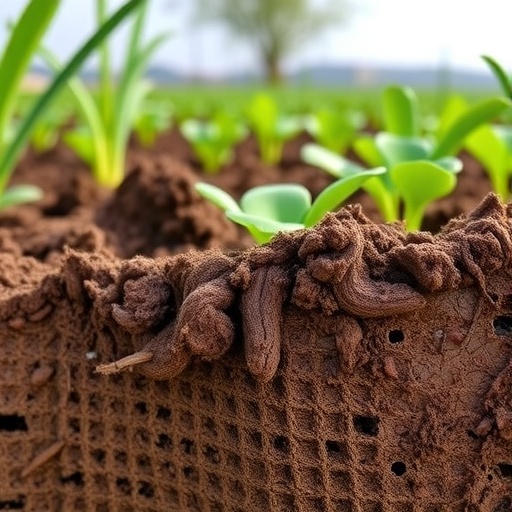In an era when environmental sustainability has become a pressing concern, innovative methodologies for remediation of polluted sites are gaining significant attention. One well-researched approach is landfarming, which involves treating contaminated soils through controlled application of organic amendments. A recent study led by Oghoje et al. investigates the effective application rates and overall efficiency of organic stimulation in the landfarming of soils heavily contaminated with petroleum hydrocarbons. This research offers valuable insights into the optimal practices for remediation that can have widespread implications for both environmental health and community wellbeing.
Landfarming is a bioremediation technique that utilizes soil to degrade hazardous organic pollutants. This method is particularly recognized for its cost-effectiveness and relatively simple operational requirements. However, the effectiveness of landfarming is largely dependent on the application rates of organic stimulants and their interaction with local soil and environmental conditions. The research by Oghoje and colleagues critically explores these components, presenting a compelling argument for refining application protocols to maximize soil recovery while minimizing downtime and environmental disruption.
Petroleum hydrocarbon pollution is a global issue that poses significant risks to ecosystems and human health. These contaminants can linger in the soil for extended periods, interfering with agriculture, biodiversity, and water quality. Oghoje et al. emphasize the need for efficient remediation strategies to restore polluted sites, advocating for the use of organic stimulation to enhance the biodegradation capabilities of soil microorganisms. By investigating various application rates, the study aims to identify optimal practices that can accelerate the degradation of hydrocarbons while restoring soil health.
The researchers employed a series of controlled experiments to analyze how different concentrations of organic amendments influence the degradation of petroleum hydrocarbons in contaminated soils. The findings elucidate the essential balance between sufficient nutrient availability, microbial activity, and the abiotic factors that govern soil health. As the study progresses, their meticulous observations underscore the importance of monitoring not only the degradation rates of contaminants but also the overall soil ecology throughout the remediation process.
One of the key findings of Oghoje and his team is the optimal threshold of organic amendment application, which significantly enhances the biodegradation processes. The research highlights that exceeding specific organic application rates can lead to diminishing returns, where the benefits plateau or even reverse, causing more harm than good to the soil ecosystem. This insight is invaluable for land management professionals seeking to implement effective remediation strategies without oversaturating the soils with unnecessary nutrients.
Furthermore, the researchers advocate for a tailored approach to organic stimulation, as different soils exhibit varying capacities for nutrient absorption and microbial activity. By examining these differences, land managers can craft customized remediation plans that account for local conditions, thus ensuring more effective and sustainable outcomes. Their rigorous analysis emphasizes that one-size-fits-all solutions are ineffective and underscores the necessity for localized approaches to environmental restoration.
A critical aspect of the research is its practical application. As society grapples with the repercussions of industrial pollution, understanding the science behind effective landfarming opens doors to practical solutions that can be implemented across various contaminated sites. Oghoje et al. not only present scientific data but also provide guidance for policymakers and practitioners working in environmental remediation. Their findings suggest actionable recommendations that can be integrated into current practices, thereby enhancing the potential for successful rehabilitation of polluted lands.
Moreover, the study casts a spotlight on the role of community involvement in environmental remediation initiatives. Engaging local communities in the restoration processes fosters a sense of ownership and awareness about environmental health. The potential for collaboration between researchers, policymakers, and local residents is significant, as collective efforts can amplify the impacts of remediation strategies. This shared responsibility for environmental stewardship is fundamental in overcoming the challenge of pollution.
In conclusion, the work of Oghoje et al. serves as a crucial contribution to the field of environmental science, particularly in the realm of soil remediation techniques. Their exploration into effective organic stimulation practices for landfarming highlights both the complexity and potential of bioremediation as a solution for petroleum hydrocarbon pollution. This research is pivotal not only for advancing scientific knowledge but also for promoting actionable practices that can lead to healthier ecosystems and communities.
As the path forward becomes clearer, the insights gained from this study will undoubtedly resonate across various stakeholders, from researchers to environmental advocates. The effective application of organic amendments stands at the frontier of innovative solutions for soil remediation—showcasing not only the power of science in addressing environmental issues but also the collaborative spirit necessary for achieving tangible results in sustainability.
The implications of such research are profound and far-reaching. By drawing attention to specific application rates and their effects on pollutant degradation, the authors invite further inquiry and exploration into this critical area. Environmental scientists and practitioners are urged to consider the findings and integrate them into future remediation efforts, ensuring that soil health is restored and maintained for future generations.
This research case presents a compelling narrative about the persistent struggle against pollution and the diligent scientific efforts aimed at mitigating its effects. As Oghoje and his colleagues continue to expand upon their work, the hope is that their findings inspire not only scientific community but also the public to advocate for healthier ecosystems, ultimately leading to a more sustainable world.
Subject of Research: Organic stimulation for landfarming of heavily petroleum hydrocarbon–polluted soils.
Article Title: The effective application rates and efficiency of organic stimulation for optimal landfarming of heavily petroleum hydrocarbon–polluted soils.
Article References:
Oghoje, S.U., Ejeomo, C., Arienmughare, E. et al. The effective application rates and efficiency of organic stimulation for optimal landfarming of heavily petroleum hydrocarbon–polluted soils.
Environ Monit Assess 197, 1300 (2025). https://doi.org/10.1007/s10661-025-14631-0
Image Credits: AI Generated
DOI: https://doi.org/10.1007/s10661-025-14631-0
Keywords: Bioremediation, petroleum hydrocarbons, landfarming, organic stimulation, environmental sustainability.




